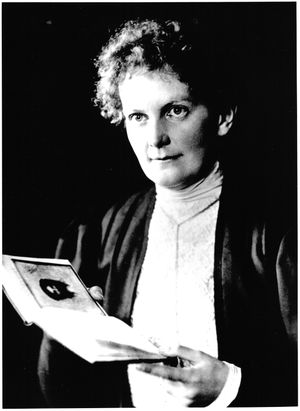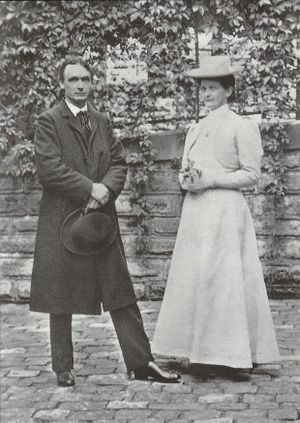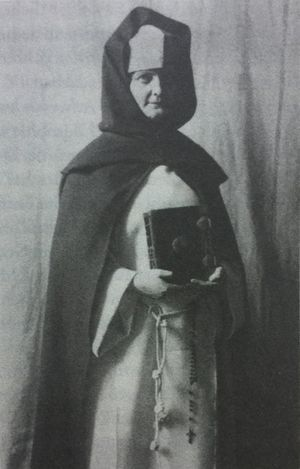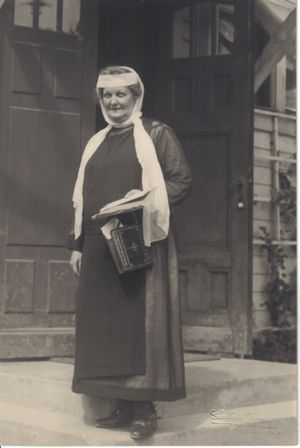Marie Steiner







Marie Steiner also Marie Steiner-von Sivers, née Marie von Sivers or Sievers, Siebers (* 14 March 1867 in Wloclawek, Poland; † 27 December 1948 in Beatenberg, Switzerland) was a Russian/German actress, theosophist, anthroposophist and the second wife of Rudolf Steiner, the founder of anthroposophy.
Life and work
Childhood and youth
Marie Steiner was born on 14 March 1867 in Wloclawek, then part of Russia, now part of Poland, as one of eight children. Her father Jacob von Sievers, who came from a Livonian family, was a military officer in Russian service with the rank of lieutenant general and was the town's commander. The mother Caroline Baum came from a Rhenish family that had settled in Archangelsk in northern Russia. Around 1874/75, the family moved to Riga due to a service transfer of the father, and around 1877, after the father's retirement, another move to Saint Petersburg followed. There Marie attended a German public school, after which she followed one of her brothers to a run-down farm near Novgorod, where she worked as a teacher. In 1894/95, the brother died and Marie had to return to St Petersburg.
Turning to art
With the financial support of her family, she studied recitation and acting at the Conservatoire de Paris from 1895 to 1897, the latter studies she continued after her return to St. Petersburg. In 1899 she received an offer to play at the Schiller Theater in Berlin, whereupon she moved to Germany. However, the confines of the stage did not suit her and she left the theatre in the same year. After becoming acquainted with and appreciating the works of Eduard Schuré, she contacted him in October 1900, whereupon a lively correspondence developed and she translated several of Schuré's works from French into German.
In the Theosophical Society
Having been alerted by a hint from Schuré, she joined the German Theosophical Society (D.T.G.) in Berlin in November 1900. There, in the same month, she met in the library of Cay Lorenz Graf von Brockdorff and his wife Sophie Gräfin von Brockdorff as well as Rudolf Steiner, who had been giving lectures in these rooms since the end of September 1900. This encounter shaped their lives from then on until her death in 1948. After Count Brockdorff had resigned from his position as leader of the Berlin D.T.G. Lodge for reasons of age, Steiner became both a member of the D.T.G. and the new leader of the Berlin Lodge on 17 January 1902, with Marie as his secretary and right-hand woman. At the foundation of the German Section of the Theosophical Society (DSdTG), which followed on 19 October 1902, Steiner took over the post of General Secretary, continuing with Marie as his secretary.
From the beginning, Sivers worked closely with Steiner and it was she who was largely responsible for the administrative and organisational work of the DSdTG. In addition, she organised Steiner's increasingly extensive lecturing activities, conducted the correspondence that became necessary, accompanied him on many of his journeys and also acted as his interpreter abroad. In order to be able to publish Steiner's numerous writings more easily, she founded the Philosophical-Theosophical Publishing House in Berlin in 1908. A major reason for this was that Steiner's works were becoming increasingly esoteric and therefore fewer and fewer publishers were prepared to publish them because of feared low sales figures. In 1913 the institution was renamed Philosophical Anthroposophical Publishing House and in 1923 moved to Dornach in Switzerland.
In the Anthroposophical Society
At the turn of the year 1912/13, serious differences led to a separation from the Theosophical Society. Steiner founded the Anthroposophical Society on 3 February 1913 and Marie took over the chairmanship of the new Society alongside Carl Unger and Michael Bauer. In 1916, however, following Steiner's advice, she relinquished this post. At the end of 1923 she became a member of the board of the newly founded General Anthroposophical Society, alongside Steiner and others.
While the new movement art of eurythmy slowly began to emerge, the Schuré play The Sacred Drama of Eleusis, translated by Sivers and directed by Steiner, was performed in parallel with a theosophical congress in Munich from 18 to 21 May 1907, and other such events followed in the years that followed. Sivers played leading roles in the mystery dramas written by Steiner, which were performed in the years 1910 to 1913, also in Munich.
On 24 December 1914, the civil marriage between her and Steiner sealed their long-lasting relationship. Anna Eunicke Steiner, Steiner's first wife, had died in 1911. Sivers took her husband's surname, but to this day she is also called Marie Steiner-von Sievers. - The marriage remained childless.
Eurythmy and speech formation
Marie Steiner had been involved in the development of what later became known as eurythmy since 1907. Its name (the ancient Greek word for "fine regularity") goes back to her suggestion. From the end of 1914 Marie Steiner, together with Rudolf Steiner, developed a special art of recitation for eurythmy, and indeed a new art of speech in general, the so-called speech formation (German: Sprachgestaltung). From the courses given together on this subject there are the records Methodology and Essence of Speech Formation, The Art of Recitation and Declamation and Speech Formation and Dramatic Art. In 1919, after the end of World War I, she travelled to several European countries, gave eurythmy performances and founded eurythmy schools. After the death of her husband, she was instrumental in ensuring that the complete Faust was performed unabridged for the first time in 1938.
Marie Steiner was very committed to the further development of eurythmy and taught the actors of the Goetheanum stage how to shape the language. She developed an art of speech choir in the twenties and built up a speech choir which was marvelled at and celebrated on its successful tours throughout Europe, as can be seen from the press of the time: "She put together an ensemble of actors at that time and with them shaped a speech choir that was considered unique and unrepeatable far beyond its time because of its elementary expressiveness and linguistic discipline."
She gave her students H. Zuelzer-Ernst and Johann Wolfgang Ernst the right to continue this speech school. However, in disputes over the heritage, the Marie Steiner School of Language in Dornach was not tolerated and led an almost unnoticed shadowy existence on the road and in Malsch near Karlsruhe.
The Rudolf Steiner Inheritance Management
After Rudolf Steiner's death, on 30 March 1925, she, as testamentary heiress, administered his entire literary and artistic inheritance. It was primarily to her credit that Rudolf Steiner's work could be published as a unity and unchanged. This task was not easy, in view of some 5900 lectures, many of which had been preserved only as stenographic notes, as well as a lengthy series of essays and letters and 28 books by Steiner.The Rudolf Steiner Complete Edition, which has not yet been published in its entirety (2021), comprises over 300 volumes, including voluminous copies, often subdivided into parts. Marie Steiner herself edited over 500 publications and compiled introductions and explanations for them.
In order to continue the work she had begun, Marie Steiner founded the "Rudolf Steiner Nachlassverwaltung, Verein zur Verwaltung des literarischen und künstlerischen Nachlasses von Dr. Rudolf Steiner" (Rudolf Steiner Inheritance Management, Association for the Management of the Literary and Artistic Estate of Dr. Rudolf Steiner) in 1943. On 1 December 1947 she officially transferred all rights to Steiner's works to it. This intention had already led to disputes with the General Anthroposophical Society (AAG) since 1945, which for its part claimed rights to Steiner's works. The differences led to a split in the AAG in 1949, and there was now also an Anthroposophical Association in Switzerland, which still exists today.
Marie Steiner died at the age of 81, on 27 December 1948, in Beatenberg.
Importance for Steiner's work and life
Marie von Sivers entered Rudolf Steiner's life a few years after the end of his time as a collaborator on the Weimar edition of Goethe's works, and was thus similarly punctual to Christiane Vulpius, who came into Goethe's life in 1788, after his return from Italy, to ask for help for her writer brother August. Marie Steiners appearance almost coincides with Steiner's founding of anthroposophy and roughly marks the beginning of the latter's esoteric period with the Theosophical and later the Anthroposophical Society. Through her knowledge of languages and her untiring artistic and human support, Sivers was a fundamental part of Rudolf Steiner's esoteric professional life from the very beginning: not only help, but also carried by understanding even for the most complex philosophical-anthroposophical submissions of her husband, which she inwardly helped to represent. In her memoirs, she paints a very realistic picture of her husband as a man who was often hostile and misunderstood, who did spiritual work in an honest way and clearly stood out from the mass of literary figures surrounding him.
Works (selection)
- Aphoristisches zur Rezitationskunst. Der kommende Tag, Stuttgart 1922
- Rudolf Steiner und die Künste, Ein Aufsatz aus dem Jahr 1927. Rudolf-Steiner-Nachlassverwaltung, Dornach 1961
- Rudolf Steiner und die redenden Künste, Eurythmie, Sprachgestaltung und dramatische Kunst, gesammelte Aufsätze und Berichte. Rudolf-Steiner-Verlag, Dornach 1974; ISBN 3-7274-5169-6
- Aus dem Wirken von Marie Steiner, Gesammelte Aufsätze. Rudolf-Steiner-Nachlassverwaltung, Dornach 1951
As translator:
- Schuré, Eduouard: Das heilige Drama von Eleusis, Rekonstruiert von Edouard Schuré, In freie Rhythmen gebracht durch Rudolf Steiner. Verlag am Goetheanum, Dornach 1939
- Schuré, Edouard: Die großen Eingeweihten, Geheimlehren der Religionen. Barth, München 1992; ISBN 3-502-65542-1
- Die Heiligtümer des Orients, Ägypten - Griechenland - Palästina. Engel und Seefels, Stuttgart 1991; ISBN 3-927118-02-8
- Solov'ev, Vladimir Sergeevich: Gedichte. Rudolf-Steiner-Nachlassverwaltung, Dornach 1969
Literature
- Hammacher, Wilfried: Marie Steiner, Lebensspuren einer Individualität. Verlag Freies Geistesleben, Stuttgart 1998; ISBN 3-7725-1798-6
- Poeppig, Fred: Marie Steiner, ein Leben im Dienst der Wiedergeburt des Wortes. Lohengrin-Verlag, Rendsburg 1990
- Rudolf-Steiner-Nachlassverwaltung (Hrsg.): Marie Steiner- von Sivers, ein Leben für die Anthroposophie , eine biografische Dokumentation in Briefen und Dokumenten, Zeugnissen von Rudolf Steiner, Maria Strauch, Edouard Schuré und anderen. Rudolf-Steiner-Verlag, Dornach 1988; ISBN 3-7274-5321-4
- Samweber, Anna: Aus meinem Leben, Erinnerungen an Rudolf Steiner und Marie Steiner- von Sivers. Verlag Die Pforte, Basel 1983; ISBN 3-85636-063-8
- Schubert, Ilona: Selbsterlebtes im Zusammensein mit Rudolf Steiner und Marie Steiner. Zbinden, Basel 1977; ISBN 3-85989-383-1
Weblinks
| This article is partly based on the article Marie Steiner from the free encyclopedia de.wikipedia and is licensed under Creative Commons Attribution/Share Alike. Wikipedia has a list of authors available. |
